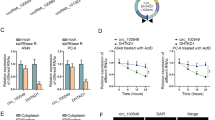Abstract
Non-small cell lung cancer (NSCLC) is the leading cause of cancer-related death worldwide and lung adenocarcinoma is its main type. MicroRNAs are small, non-coding and single-strand RNAs that regulate gene expression in human cancers. The aim of our study is to investigate the underlying molecular mechanism of miR-142-3p in NSCLC. The expression of miR-142-3p in lung adenocarcinoma tissues and cells was detected by RT-qPCR. Next, cell proliferation, migration, invasion and apoptosis were examined by CCK-8, scratch assay, transwell assay and flow cytometry in A549 and HCC827 cells, respectively. Then, the target of miR-142-3p was predicted by targetscanHuman 7.2 and confirmed using dual-luciferase reporter assay. Additionally, RT-qPCR and western blot were used to detect the expression of NR2F6, MMP2, MMP9 and caspase-3. The results showed that miR-142-3p expression was significantly decreased in tumor tissues and cells. Overexpression of miR-142-3p inhibited the proliferation, migration, invasion and promoted cell apoptosis in vitro, while knockdown of miR-142-3p had reversed function. Furthermore, NR2F6 was identified as a direct target of miR-142-3p, which was negatively correlated with miR-142-3p expression. Finally, miR-142-3p overexpression suppressed the expression of NR2F6, MMP2 and MMP9, but improved caspase-3 expression, while miR-142-3p knockdown got the opposite expression results. Suppressing MMP2 and MMP9 activities inhibited cell invasion. In summary, these findings indicated that miR-142-3p inhibits lung adenocarcinoma cell proliferation, migration and invasion, and enhances cell apoptosis by targeting NR2F6, suggesting that miR-142-3p may be a novel therapeutic target for lung adenocarcinoma treatment.






Similar content being viewed by others
References
Dela Cruz CS, Tanoue LT, Matthay RA. Lung cancer: epidemiology, etiology, and prevention. Clin Chest Med. 2011;32:605–44.
Koudelakova V, Kneblova M, Trojanec R, Drabek J, Hajduch M. Non-small cell lung cancer—genetic predictors. Biomed Pap Med Fac Univ Palacky Olomouc Czech Repub. 2013;157:125–36.
Siegel RL, Miller KD, Jemal A. Cancer statistics, 2016. CA Cancer J Clin. 2016;66:7–30.
Miller KD, Siegel RL, Lin CC, et al. Cancer treatment and survivorship statistics, 2016. CA Cancer J Clin. 2016;66:271–89.
Bui KT, Cooper WA, Kao S, Boyer M. Targeted molecular treatments in non-small cell lung cancer: a clinical guide for oncologists. J Clin med. 2018;7:192.
Bartel DP. MicroRNAs: genomics, biogenesis, mechanism, and function. Cell. 2004;116:281–97.
Farazi TA, Hoell JI, Morozov P, Tuschl T. MicroRNAs in human cancer. Adv Exp Med Biol. 2013;774:1–20.
Hime GR, Somers WG. Micro-RNA mediated regulation of proliferation, self-renewal and differentiation of mammalian stem cells. Cell Adh Migr. 2009;3:425–32.
Vescovo VD, Grasso M, Barbareschi M, Denti MA. MicroRNAs as lung cancer biomarkers. World J Clin Oncol. 2014;5:604–20.
Shrestha A, Mukhametshina RT, Taghizadeh S, et al. MicroRNA-142 is a multifaceted regulator in organogenesis, homeostasis, and disease. Dev Dyn. 2017;246:285–90.
Liu X, Sempere LF, Galimberti F, et al. Uncovering growth-suppressive microRNAs in lung cancer. Clin Cancer Res. 2009;15:1177–83.
Xiao P, Liu WL. MiR-142-3p functions as a potential tumor suppressor directly targeting HMGB1 in non-small-cell lung carcinoma. Int J Clin Exp Pathol. 2015;8:10800–7.
Cao XC, Yu Y, Hou LK, et al. MiR-142-3p inhibits cancer cell proliferation by targeting CDC25C. Cell Prolif. 2016;49:58–68.
Nimmo R, Ciau-Uitz A, Ruiz-Herguido C, et al. MiR-142-3p controls the specification of definitive hemangioblasts during ontogeny. Dev Cell. 2013;26:237–49.
Naqvi AR, Fordham JB, Nares S. MiR-24, miR-30b, and miR-142-3p regulate phagocytosis in myeloid inflammatory cells. J Immunol. 2015;194(4):1916–27.
Carraro G, Shrestha A, Rostkovius J, et al. MiR-142-3p balances proliferation and differentiation of mesenchymal cells during lung development. Development. 2014;141:1272–81.
Wu L, Cai C, Wang X, Liu M, Li X, Tang H. MicroRNA-142-3p, a new regulator of RAC1, suppresses the migration and invasion of hepatocellular carcinoma cells. FEBS Lett. 2011;585:1322–30.
Schwickert A, Weghake E, Brüggemann K, et al. MicroRNA miR-142-3p inhibits breast cancer cell invasiveness by synchronous targeting of WASL, integrin alpha V, and additional cytoskeletal elements. PLoS One. 2015;10:e0143993.
Shen WW, Zeng Z, Zhu WX, Fu GH. MiR-142-3p functions as a tumor suppressor by targeting CD133, ABCG2, and Lgr5 in colon cancer cells. J Mol Med (Berl). 2013;91:989–1000.
Zhu J, Tian X, Zhang Y, Bai Y, Pei K. MiR-142-3p is a tumor promoter by directly targeting FOXO4 to promote gastric cancer cell growth and suppress cell apoptosis in gastric cancer. Int J Clin Exp Pathol. 2016;9:12079–87.
Gao X, Xu W, Lu T, Zhou J, Ge X, Hua D. MicroRNA-142-3p promotes cellular invasion of colorectal cancer cells by activation of RAC1. Technol Cancer Res Treat. 2018;17:1533033818790508.
Li Y, Chen D, Jin L, et al. Oncogenic microRNA-142-3p is associated with cellular migration, proliferation and apoptosis in renal cell carcinoma. Oncol Lett. 2016;11:1235–41.
Lei Z, Xu G, Wang L, et al. MiR-142-3p represses TGF-β-induced growth inhibition through repression of TGFβR1 in non-small cell lung cancer. FASEB J. 2014;28:2696–704.
Giguère V. Orphan nuclear receptors: from gene to function. Endocr Rev. 1999;20:689–725.
Hermann-Kleiter N, Klepsch V, Wallner S, et al. The nuclear orphan receptor NR2F6 is a central checkpoint for cancer immune surveillance. Cell Rep. 2015;12:2072–85.
Niu C, Sun X, Zhang W, et al. NR2F6 expression correlates with pelvic lymph node metastasis and poor prognosis in early-stage cervical cancer. Int J Mol Sci. 2016;17:E1694.
Li XB, Jiao S, Sun H, et al. The orphan nuclear receptor EAR2 is overexpressed in colorectal cancer and it regulates survivability of colon cancer cells. Cancer Lett. 2011;309:137–44.
Muscat GE, Eriksson NA, Byth K, et al. Research resource: nuclear receptors as transcriptome: discriminant and prognostic value in breast cancer. Mol Endocrinol. 2013;27:350–65.
Ichim CV, Atkins HL, Iscove NN, Wells RA. Identification of a role for the nuclear receptor EAR-2 in the maintenance of clonogenic status within the leukemia cell hierarchy. Leukemia. 2011;25:1687–96.
Klepsch V, Hermann-Kleiter N, Do-Dinh P, et al. Nuclear receptor NR2F6 inhibition potentiates responses to PD-L1/PD-1 cancer immune checkpoint blockade. Nat Commun. 2018;9:1538.
Kessenbrock K, Plaks V, Werb Z. Matrix metalloproteinases: regulators of the tumor microenvironment. Cell. 2010;141:52–67.
Jian H, Zhao Y, Liu B, Lu S. SEMA4b inhibits MMP9 to prevent metastasis of non-small cell lung cancer. Tumour Biol. 2014;35:11051–6.
Wang H, Guan X, Tu Y, et al. MicroRNA-29b attenuates non-small cell lung cancer metastasis by targeting matrix metalloproteinase 2 and PTEN. J Exp Clin Cancer Res. 2015;34:59.
Porter AG, Jänicke RU. Emerging roles of caspase-3 in apoptosis. Cell Death Differ. 1999;6:99–104.
Cui R, Kim T, Fassan M, et al. MicroRNA-224 is implicated in lung cancer pathogenesis through targeting caspase-3 and caspase-7. Oncotarget. 2015;6:21802–15.
Sledge GW Jr, Qulali M, Goulet R, et al. Effect of matrix metalloproteinase inhibitor batimastat on breast cancer regrowth and metastasis in athymic mice. J Natl Cancer Inst. 1995;87:1546–50.
Stamenkovic I. Matrix metalloproteinases in tumor invasion and metastasis. Semin Cancer Biol. 2000;10:415–33.
Zhang K, Chen D, Jiao X, et al. Slug enhances invasion ability of pancreatic cancer cells through upregulation of matrixmetalloproteinase-9 and actin cytoskeleton remodeling. Lab Invest. 2011;91:426–38.
Yang XC, Wang X, Luo L, et al. RNA interference suppression of A100A4 reduces the growth and metastatic phenotype of human renal cancer cells via NF-kB-dependent MMP-2 and bcl-2 pathway. Eur Rev Med Pharmacol Sci. 2013;17:1669–80.
Acknowledgements
The present study was funded by the Sanming Project of Shenzhen Health and Family Planning Commission (SZSM201512016), Sanming Project of Medicine in Shenzhen (SZSM201612027) and Shenzhen Science Foundation (JCYJ20170413161913429).
Author information
Authors and Affiliations
Corresponding author
Ethics declarations
Conflict of interest
The authors declare that they have no competing interest.
Additional information
Publisher's Note
Springer Nature remains neutral with regard to jurisdictional claims in published maps and institutional affiliations.
Rights and permissions
About this article
Cite this article
Jin, C., Xiao, L., Zhou, Z. et al. MiR-142-3p suppresses the proliferation, migration and invasion through inhibition of NR2F6 in lung adenocarcinoma. Human Cell 32, 437–446 (2019). https://doi.org/10.1007/s13577-019-00258-0
Received:
Accepted:
Published:
Issue Date:
DOI: https://doi.org/10.1007/s13577-019-00258-0




